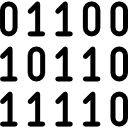Truth tables: Difference between revisions
Mr. MacKenty (talk | contribs) (Created page with "<center> <blockquote style="padding: 5px; background-color: #FFF8DC; border: solid thin gray;"> File:Exclamation.png This is an '''important concept'''. You should ful...") |
Mr. MacKenty (talk | contribs) No edit summary |
||
| (12 intermediate revisions by the same user not shown) | |||
| Line 1: | Line 1: | ||
[[File:binary.png|frame|right|This is a basic concept in computer science]] | [[File:binary.png|frame|right|This is a basic concept in computer science]] | ||
A truth table is a mathematical table used in logic—specifically in connection with Boolean algebra, boolean functions, and propositional calculus—to compute the functional values of logical expressions on each of their functional arguments, that is, on each combination of values taken by their logical variables (Enderton, 2001). In particular, truth tables can be used to tell whether a propositional expression is true for all legitimate input values, that is, logically valid.<ref>https://en.wikipedia.org/wiki/Truth_table</ref> | |||
To determine the total number of possible permutations of <syntaxhighlight lang="python" inline>n</syntaxhighlight> given inputs you'll need 2^n input combinations to test. | |||
== | == Truth Tables == | ||
Please be aware in the video below they use specific symbols for logic symbols. The IB DOES NOT REQUIRE YOU TO USE SPECIFIC SYMBOLS. You can just draw a circle with the word AND or OR or NOT, etc... | |||
<html> | <html> | ||
<iframe width="560" height="315" src="https://www.youtube.com/embed/ | <iframe width="560" height="315" src="https://www.youtube.com/embed/osI68WZz_CM" frameborder="0" allow="accelerometer; autoplay; encrypted-media; gyroscope; picture-in-picture" allowfullscreen></iframe> | ||
</html> | </html> | ||
== Do you understand this topic? == | == Do you understand this topic? == | ||
* Define the Boolean operators: AND, OR, NOT, NAND, NOR and XOR. | |||
* Construct truth tables using the above operators. | |||
* Construct a logic diagram using AND, OR, NOT, NAND, NOR and XOR gates. | |||
== Do you have an advanced understanding about this topic? == | |||
== See Also == | == See Also == | ||
* [[Boolean operators]] | |||
* [[Logic diagram]] | |||
== References == | == References == | ||
Latest revision as of 13:44, 22 October 2019
A truth table is a mathematical table used in logic—specifically in connection with Boolean algebra, boolean functions, and propositional calculus—to compute the functional values of logical expressions on each of their functional arguments, that is, on each combination of values taken by their logical variables (Enderton, 2001). In particular, truth tables can be used to tell whether a propositional expression is true for all legitimate input values, that is, logically valid.[1]
To determine the total number of possible permutations of n given inputs you'll need 2^n input combinations to test.
Truth Tables[edit]
Please be aware in the video below they use specific symbols for logic symbols. The IB DOES NOT REQUIRE YOU TO USE SPECIFIC SYMBOLS. You can just draw a circle with the word AND or OR or NOT, etc...
Do you understand this topic?[edit]
- Define the Boolean operators: AND, OR, NOT, NAND, NOR and XOR.
- Construct truth tables using the above operators.
- Construct a logic diagram using AND, OR, NOT, NAND, NOR and XOR gates.
